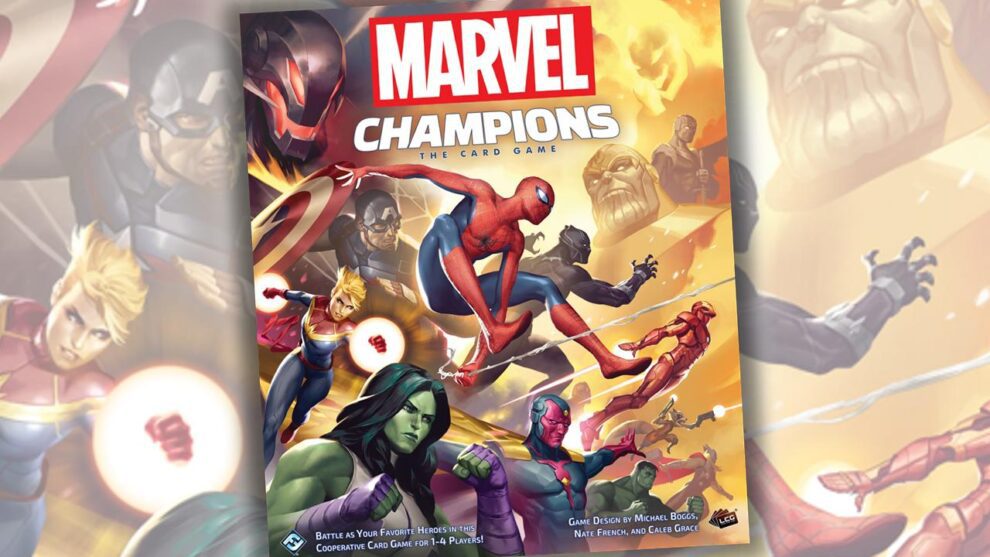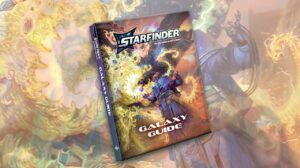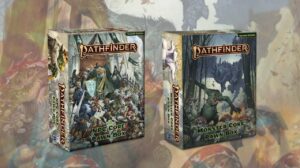As I’ve become more cognizant of the size of my burgeoning board game collection, I often find myself culling games from the shelf that are replaced by better versions of a similar game. That meant that Legendary: A Marvel Deck Building Game finally found its way to the seller’s block when Marvel Champions: The Card Game came home to roost. Saving the universe and the streets of Queens never looked so good.
Marvel Champions: The Card Game Overview
Marvel Champions: The Card Game (which, henceforth, I’ll be simply calling Marvel Champions) is a living card game. This means that there is a core box designed to get you started and there are also new expansions of varying sizes to keep you coming back for more. For the sake of this review, I’ll only focus on the core game, which contains five heroes and three villains.
The game starts with each player choosing which hero they want to use, along with the singular villain that the collective table wants to square off against. Marvel Champions designed their introduction well, packaging up prebuilt Spider-Man and Captain Marvel decks for a two-player game against Rhino. There’s even a separate Learn to Play booklet that will walk you through the basics for your first game, which is most welcome.
If you’ve played any other trading card games or living card games before, then many of the core concepts of the game will seem familiar to you. When used, cards are turned sideways to indicate they are exhausted, meaning that they can’t be used until readied again at the end of your turn. There are hit points for yourself and the enemy, and the standard goal is to make your enemy hit zero before their Scheme is completed.
That’s where the primary tug-of-war comes into play with Marvel Champions. Each hero can change between their Hero form and their Alter-Ego once per turn. Besides both having unique abilities that they can leverage, the Alter-Ego side tends to be better at removing Threat from the enemy Schemes, while the Hero side tends to be more adept at dishing out damage. Understanding when you should take a step back and regroup is an important concept to learn.
The enemy also has their own deck to work from, taking their turn after the players have gone. These are filled with Minions to flesh out their side of the battlefield, along with Side-Schemes that ramp up the Threat against the Heroes. Of course, you’ll have friendly Allies of your own to assist with dispatching the baddies.
What really takes the cake, however, is that each Hero deck has character-specific Obligation cards that are slotted into the enemy deck. Peter Parker, for example, has Eviction Notice which requires a choice between switching to Alter-Ego form and exhausting the card, or you can opt to discard a random card from your hand and draw a second encounter card to replace it.
Even with just the core box, you’ll have plenty of Hero combinations to keep you busy as you thwart Rhino, Klaw, and Ultron’s dastardly schemes.

Marvel Champions: The Card Game – You Can Do This All Day
When it comes to gameplay, I really appreciate the flow of the game. Players go, and then the Villain goes. There isn’t a lot of fiddly management of components or resetting things each turn besides readying and drawing cards. This keeps things streamlined, especially if you’re playing solo but managing multiple heroes.
There is also an inherent tension that builds as the game goes on. Having dual clocks – Health and Threat – forces you to make tough decisions as a player about which lowercase threat is more immediate. Do you decide to handle the Scheme, and hopefully, your Allies can handle the Minions, or do you keep pressing the attack and cross your fingers that you can outlast the enemy?
Being able to use cards in your hand as the energy to pay for other cards is one of my favorite ways to leverage the mechanic of hand cycling, since you are essentially discarding those cards instead of playing them. I’m the kind of person who likes to dump out as many cards as possible because keeping a niche card in your hand for multiple turns in hopes that a usable situation presents itself is just squandering your own resource use.
The game isn’t perfect, however. As with any card game like this, sometimes you are set up for failure simply in how the decks present themselves. If the villain manages to draw a ton of encounters that your hand isn’t equipped to deal with, you can find yourself spinning your wheels while you delay the inevitable. There can be great moments of overcoming such obstacles and weaving a fantastic tale around it, but it can be daunting.
The other quibble I have with Marvel Champions centers around the component management aspect of the game. For example, when you’re packing up the game you need to remember to remove all of the character-specific cards and store them together in the box. If you don’t like organizing, you may find yourself in a world of hurt trying to hunt down Black Panther’s Obligations that somehow ended up with a stack of Captain Marvel’s cards. It’s a side-effect of using a shared deck, but never one that I’ve enjoyed.
After you’ve tackled Rhino and the other core box villains, there are built-in rules to ramp up the difficulty with Expert mode, or you can even just add village stage cards to the mix and leave out the Expert encounter cards if you just want a more medium-difficulty experience. The modularity of Marvel: Champions is on a completely different level, and before long, you’ll have Wolverine and X-23 taking on the Sinister Six!

Marvel Champions: The Card Game Eases You into the Multiverse
Let’s face it: getting into a Living Card Game is a huge hurdle to overcome, especially when the game has been around for more than five minutes. Between navigating an existing community, understanding card interactions, theory-crafting, and a backlog of content, there are always barriers to entry.
That being said, Marvel: Champions is one of the easier card games to get into, and serves as a prime example of designing a game where the mechanics are approachable from the onset.
I could play with just the core game and be perfectly content; there’s plenty of challenge, variability, and opportunity to mix-and-match with the various decks to create scenarios to keep me occupied for the foreseeable future. That’s a major strength of the game, because it doesn’t make you feel obligated to necessarily go buy more boxes and fully complete the card set with everything.
But we can’t forget that this is a Marvel-licensed game, and Fantasy Flight knows the target demographic here. The game may not force you to buy content, but with the expansive Earth-616 universe (and then some), Marvel fans are bound to have a handful of heroes and villains that serve as their favorites. And those are the ones that you’re going to want to buy. Selling so many heroes in individual Hero packs is genius; I don’t want to have to buy a huge box when I have my eye on a single hero. Not all the time at least.
Marvel Champions: The Card Game is the Mark VI of Card Games
From web-slingers to Wakandan kings, Marvel fans finally have a game they can sink their teeth into. Whether you want something more variable than Marvel United, less cumbersome than Legendary: A Marvel Deck Building Game, more strategic than Infinity Gauntlet: A Love Letter Game, more cooperative than Marvel Villainous, or with more comic-driven art than Thanos Rising, Marvel Champions iterates on what makes card games fun while doing justice to the heroes that dish it out.
And if there’s one thing I’ve learned, it’s that writing about Marvel: Champions has only made me want to play Marvel: Champions more, and a visit to my FLGS is finding its way onto my To-do list.












